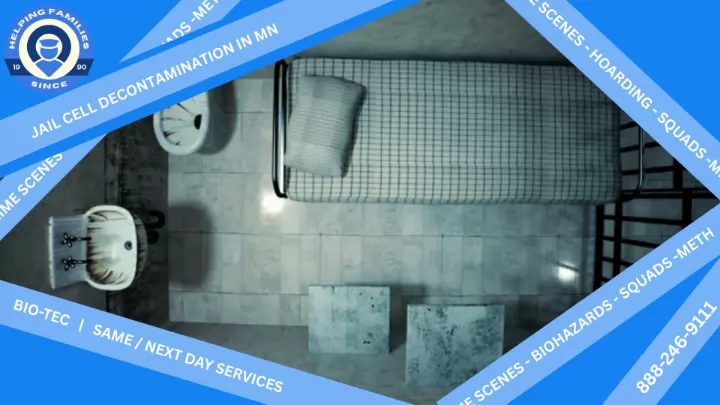Do all meth labs produce detectable contamination?
Not all meth labs produce high levels of contamination, but most do. The level depends on how often meth was cooked, the method used, and the materials involved. Even small-scale, one-time meth cooks can leave behind detectable�and dangerous�residues. Some users smoke meth indoors rather than manufacture it, which still leads to contamination, particularly in enclosed or poorly ventilated spaces. Certified testing professionals use specific sampling techniques and equipment that can detect even trace amounts of meth on walls, counters, and HVAC systems, ensuring nothing is missed regardless of the meth lab�s size or duration.
What should I look for in a hoarding cleanup service?
When choosing a hoarding cleanup service, look for a company with experience, proper licensing, and trained professionals who specialize in hoarding cases. A reputable service should offer a free assessment, a customized cleanup plan, and follow-up support. Check for positive customer reviews, confidentiality policies, and additional services such as biohazard cleanup, organization assistance, and mental health referrals. It�s also important to choose a service that demonstrates compassion and understanding, as hoarding cleanup can be an emotional process.
Why is air quality testing important for real estate transactions?
Air quality testing is becoming an integral part of real estate transactions, as it ensures that properties meet health and safety standards. Testing can uncover hidden issues like mold, radon, or asbestos, which could significantly affect a propertys value and marketability. For buyers, it provides peace of mind that the home or building is safe for occupancy. For sellers, it adds credibility and transparency to the sale, potentially increasing buyer confidence and speeding up the transaction process. In commercial real estate, air quality testing is essential for meeting regulatory requirements and maintaining tenant satisfaction.
Are there legal and regulatory requirements for suicide cleanup?
Yes, there are significant legal and regulatory requirements governing suicide cleanup, primarily due to the biohazardous nature of the scene. The Occupational Safety and Health Administration (OSHA) is the primary federal agency that sets standards for worker safety, and its **Bloodborne Pathogens Standard (29 CFR 1910.1030)** is highly relevant. This standard dictates strict guidelines for employees who may be exposed to blood or other potentially infectious materials (OPIM), requiring specific training, personal protective equipment (PPE), exposure control plans, and procedures for vaccination and post-exposure evaluation. Furthermore, the **Environmental Protection Agency (EPA)** and state-specific environmental regulations govern the proper handling, transportation, and disposal of biohazardous waste. This means that blood, tissue, and contaminated porous materials cannot simply be thrown into regular trash; they must be treated as medical waste and disposed of by licensed facilities. Some states also have specific laws or regulations pertaining to trauma scene cleanup, defining what constitutes a regulated medical waste and outlining proper cleanup procedures. Property owners themselves can be held liable if improper cleanup leads to health hazards for future occupants. Professional cleanup companies are knowledgeable about these intricate regulations and possess the necessary licenses and permits for biohazard waste transportation and disposal, ensuring the cleanup is performed legally and safely. Attempting a DIY cleanup without adherence to these regulations can lead to fines, legal repercussions, and ongoing health and safety risks.
What are the signs of a rodent infestation?
Signs include droppings, gnaw marks, nesting materials, unusual odors, and scratching noises. Prompt action is essential to prevent further contamination and damage.
What certifications do blood cleanup professionals have?
Professionals often hold certifications in biohazard remediation, bloodborne pathogen training, and OSHA compliance. These credentials ensure they are qualified to handle hazardous materials safely and effectively.
Do odor removal services disrupt daily operations?
Professional odor removal services are designed to minimize disruption to daily operations. Treatments can be scheduled during non-business hours or off-peak times to accommodate clients needs. Many techniques, such as ozone therapy or HVAC cleaning, are fast and efficient, allowing businesses to resume operations quickly. Professionals work discreetly and efficiently, ensuring that the odor removal process is seamless and convenient for clients.
How do professionals clean residual odors from squad cars after biohazard removal?
Odor-neutralizing equipment such as ozone generators is used to fully eliminate lingering smells.
How long does tear gas cleanup take?
The duration of tear gas cleanup depends on various factors, including the size of the affected area, the extent of contamination, and the specific cleanup methods employed. In some cases, cleanup may be completed in a matter of hours, while more extensive contamination may require days or weeks of remediation efforts.
How is hazardous material disposed of in a crime scene cleanup?
Hazardous materials are collected, contained, and disposed of according to strict environmental regulations and biohazard waste disposal protocols.
